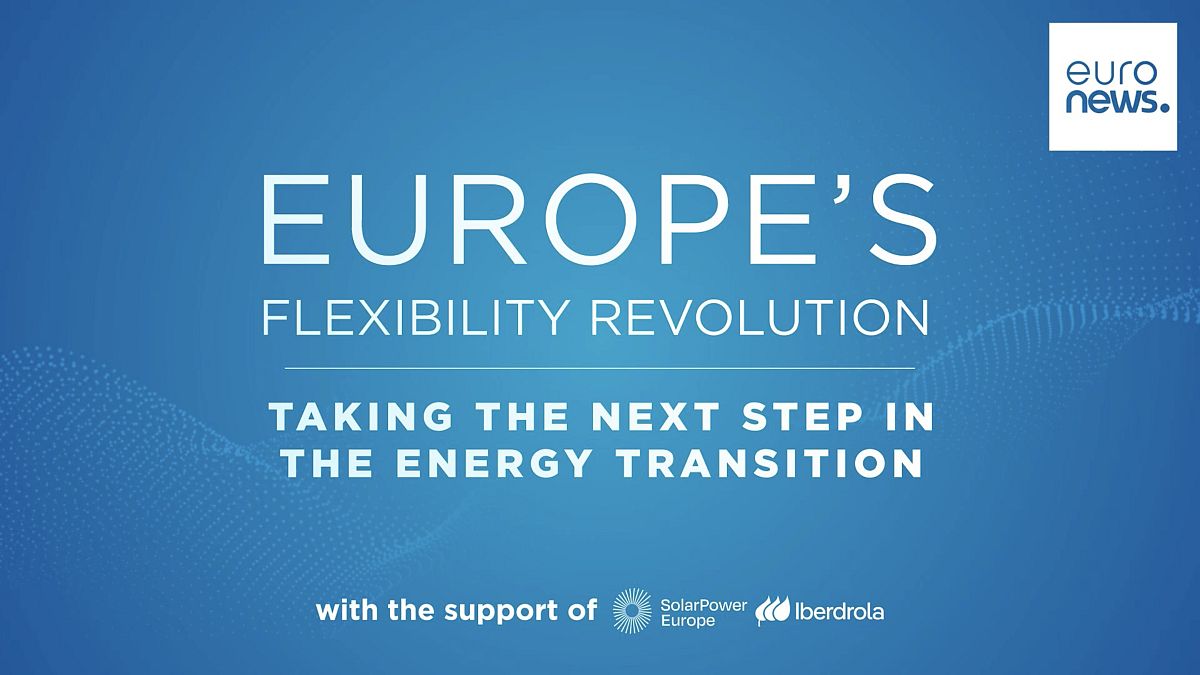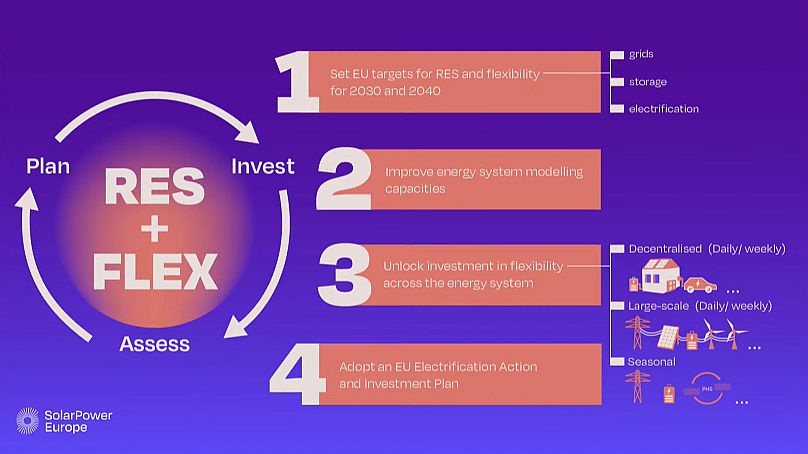How solar power, electrification and flexibility can help secure a bright future for Europe’s energy transition
The sun is shining brightly on Europe's energy sector. The European Union is on track to become a global solar powerhouse, with ambitious goals of reaching 750 GW by 2030.
But the sun doesn't always shine. The challenge now lies in creating a system that can handle the fluctuating nature of renewables, upending energy management as we know it.
For this special Euronews live policy event, Europe’s Flexibility Revolution: Taking the Next Step in the Energy Transition, we invited the CEO of SolarPower Europe, Walburga Hemetsberger, to present findings from the Mission Solar 2040 report, outlining how Europe is faring on the road to decarbonisation and its necessary next steps, with particular emphasis on solar power.
Following Hemetsberger’s talk, Robert Hodgson, the Senior Environment and Energy Reporter at Euronews’ new policy unit, led a panel discussion with industry leaders, representatives and policymakers to further discuss what needs to be done to ensure a smooth energy transition.
Among the distinguished panellists were Francois Beaude, Strategy Lead from the EU Agency for the Cooperation of Energy Regulators (ACER); Juan Rivier Abbad, Head of Renewables Regulation at Iberdrola; Stefano Grassi, EU Energy Commission Head; and Sonya Twohig, Secretary-General of the European network of Transmission System Operators (ENTSO-E)
Solar power growth
The success of solar is evident on rooftops across Europe. From 1 gigawatt (GW) of installed capacity in 2004 to 269 GW in 2023, Europe is well on its way to reaching its 2030 goals.
“Solar PV is on a mission to support Europe to become the most secure, cleanest and most prosperous continent in the world.” Hemetsberger, CEO of SolarPower Europe explained. “[But], this is only possible if we are embarking on a flexibility revolution.”
Flexibility, Hemetsberger explains, is a significant factor in achieving Europe’s decarbonisation goals, alongside a drive for quick electrification. Mission Solar 2040 outlines the "flexibility revolution" as not only the kinds of flexibility we can see, but also how we enable flexibility, for example through battery storage solutions at home and on the grid.
Three scenarios for solar power
To illustrate Europe’s future, SolarPower Europe worked with leading European planners to model three different scenarios for 2040, alongside projected figures on energy system costs, energy prices, total capacity and Co2 reductions. These are:
- Solar as Usual: Limited flexibility and electrification
- Solar and Flexibility: Increased focus on battery storage and cross-border grids
- Solar, Flexibility and Electrification: Includes electrification of vehicles, heat pumps, and electrolyzers.
Scenario three – solar plus flexibility and electrification – is Hemetsberger’s dream scenario. Alongside electrification, flexibility on the demand side is switched on, adding lots of electric vehicles, heat pumps and electrolyzers into the market.
In this case, Europe’s goal of 750 gigawatts by 2023 is not only attainable but surpassable. “We could reach more than 1.2 terawatts by 2030,” Hemetsberger explains. “And we could double that by 2040, reaching more than 2.4 terawatt by 2040. But it needs the next steps to be taken. It needs the flexibility revolution.”
Benefits of flexibility and electrification
According to projections, if Europe increases supply and demand flexibility and fixes its electrification goals, Europe could see a radical reduction in greenhouse gas emissions, up to 151 million tonnes of CO2 reductions annually by 2030 and as much as 555 million tonnes by 2040.
Cost saving would also go through the roof at both a system and consumer level. Projections state that €160 billion in energy system costs could be cut annually by 2040, while consumers would see a 33 per cent reduction in their electricity costs by 2040.
Based on SolarPower Europe’s dream scenario, electricity costs across Europe would drop by 25 per cent by 2030 and 33 per cent by 2040.
Unlocking the Flexibility Revolution
As well as projections, SolarPower Europe also offers a comprehensive action plan to enable Europe to meet its climate and energy transition goals. This plan includes four key aspects:
- Setting new EU targets for renewables, storage, and grids for both 2030 and 2040
- Improving energy system modelling capacities
- Unlocking investments in decentralised, large-scale, and seasonal flexibility solutions
- Adopting an EU Electrification Action and Investment Plan with a target of at least 50% electrification by 2040 or 2050.
Setting EU targets on flexibility
In line with point one of the plan, Hemetsberger spoke on logistics. “First we need to set new targets for renewables and those targets need to be complemented by grid storage targets. Not just for 2030 but also for 2040. We already have renewable targets for 2030 but we do not yet have flexibility targets.”
Stefano Grassi, Head of Cabinet for the Commissioner of Energy, later added the Commission’s perspective. “When we started on our Green Deal journey, our focus was on how fast we can go in replacing fossil fuel with green technologies. What are the enabling conditions? What are the targets? What are the incentives and the financing? What we have learned over these five years is that what matters is the context around this generation; the grids, the flexibility.”
Improving system modelling capacities
Implementing a radical new energy system also requires forward thinking. “We need to make sure that any planning, any failures in planning, are not putting the energy transition at risk,” Hemetsberger says. As well as a solid plan, Hemetsberger calls for proper funding to implement the National Energy and Climate Plans, on both a European and national level.
Though grid operators are required to do some planning and modelling, Hemetsberger argues that the European Commission needs to improve this process, looking at new, high quality tools that help member states, grid operators and regulators create reliable and comprehensive needs assessments.
National Energy and Climate Plans (NECP) are required of all EU governments. The plans outline how each member state aims to achieve the 2030 targets already set, including the renewable energy target. By analysing current plans, Hemetsberger reflected that most member states set high ambition on solar, but not the same ambition when it comes to improving grids, storage capacity and flexibility more generally.
Sonya Twohig, Secretary-General of ENTSO-E, (European network of Transmission System Operators) later agreed that analysis was key. “It's very important that learnings from the last five to ten years of NECPs are [taken into] the future, because this will determine how we plan Europe's power system, Europe's network, and what we can expect from it.”
Unlocking investment in decentralised, large-scale and flexible solutions
Point three in Mission Solar 2040’s plan is to unlock investments in flexibility across a decentralised, large scale, and seasonal energy system.
Our debate panel discussed the use of market incentives to achieve this. “We have huge investments coming into renewables, flexibility and grids. We want to do that in a way that is not too costly for our citizens and our companies, said Francois Beaude, Strategy Lead of the EU Agency for the Cooperation of Energy Regulators (ACER), the agency helping national authorities monitor energy markets and implement EU policy.
Not everyone was in agreement about the case for investors, citing the difficulty in getting investors interested in green technologies that would cheapen over time. To counter this, Hemetsberger outlines two solutions; reduced curtailment (reducing wasted energy at times of grid congestion) and strengthening of the solar capture price (what solar investors can earn).
“Solar plus flexibility and electrification would be a win-win for both investors and the public.” Hemetsberger said. “Under this scenario, it is projected that investors will be earning 71 per cent more in 2030, and 54 per cent in 2040. At the same time, consumers are still saving between 25 and 33 per cent on their electricity bills.”
Adopt an EU Electrification Action and Investment Plan
SolarPower Europe is asking European leaders to take up an electrification action and investment plan quickly, within 100 days of the new mandate.
Sonya Twohig, Secretary-General of ENTSO-E, used her platform to call for strong leadership in the monitoring and rollout of these plans, enabling implementation on a vast scale.
It came to the Energy Commissioner’s Head of Cabinet to temper expectations. “We may not see an action plan for electrification in the first 100 days, because this is a moment where we need to settle things,” Grassi says. “We have a lot of reforms that have just entered into force. The right moment to have this reflection is when we set the 2040 target for decarbonisation.”
When pushed for a date on this target announcement, Grassi is clear. “You should ask the new president,” he told Hodgson.
Now is not the time for stalling
It’s clear that Europe has its work cut out if it is to meet its decarbonisation goals. Reaching Europe’s goal of a 42 per cent total share of renewable electricity by 2030 will require almost doubling what we have at the moment, panel host Robert Hodgson warns. In the electricity sector, that figure is even higher, roughly 70 percent by the end of the decade.
If Mission Solar 2040 is right, this can be achieved by enacting a significant increase in grid flexibility and implementing electrification targets right away, all while adding in substantial investment and forward-thinking policy incentives.
But these strong demands, alongside another legally binding target for renewables by 2040 and separate targets for storage and flexibility, all come at a time of flux for the European parliament.
Guided by the ambitious projections in the SolarPower Europe report, however, our panellists remain optimistic.
Euronews events
Euronews events operates from the heart of Brussels, providing in-depth coverage of European affairs for our EU-wide audiences. With the launch of Euronews new policy hub, we now host regular events, panels discussions and debates on timely European issues, hearing the opinions of industry insiders, business leaders and policymakers and pushing the conversation forward.
For more information on upcoming Euronews policy events, please contact the Euronews Events team at events@euronews.com
You can also subscribe to The Policy Briefing newsletter which will keep you up to date on news and events affecting the EU regulatory scene.














